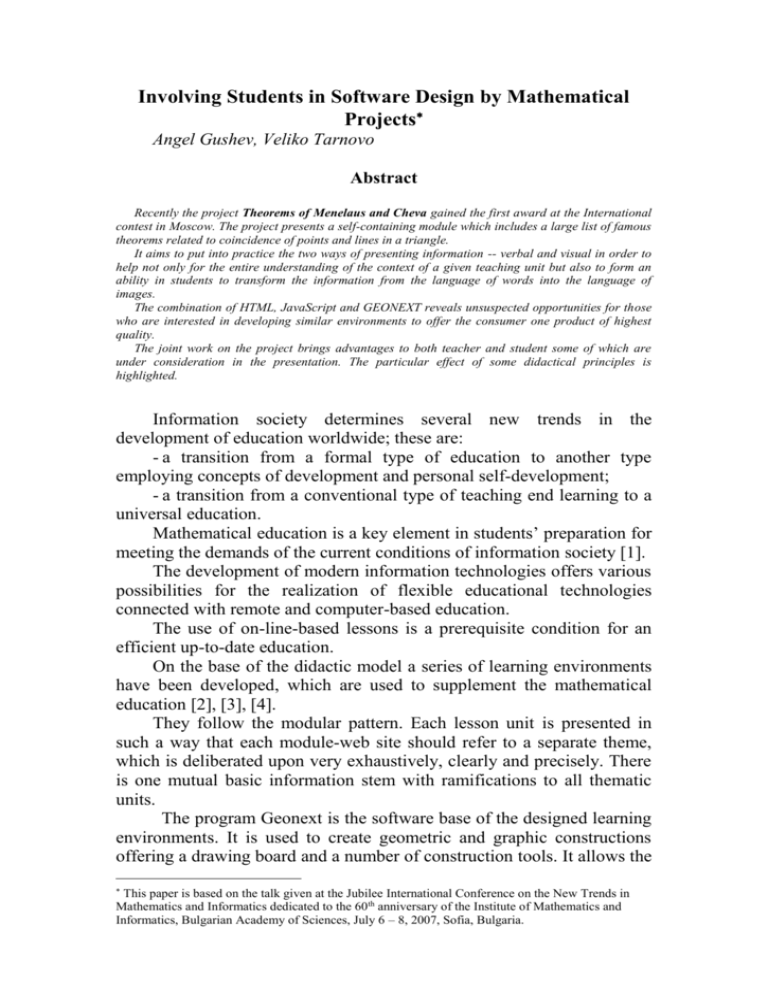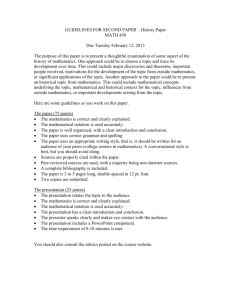Involvement of Students in the Development of Specialized Software
advertisement

Involving Students in Software Design by Mathematical Projects Angel Gushev, Veliko Tarnovo Abstract Recently the project Theorems of Menelaus and Cheva gained the first award at the International contest in Moscow. The project presents a self-containing module which includes a large list of famous theorems related to coincidence of points and lines in a triangle. It aims to put into practice the two ways of presenting information -- verbal and visual in order to help not only for the entire understanding of the context of a given teaching unit but also to form an ability in students to transform the information from the language of words into the language of images. The combination of HTML, JavaScript and GEONEXT reveals unsuspected opportunities for those who are interested in developing similar environments to offer the consumer one product of highest quality. The joint work on the project brings advantages to both teacher and student some of which are under consideration in the presentation. The particular effect of some didactical principles is highlighted. Information society determines several new trends in the development of education worldwide; these are: - a transition from a formal type of education to another type employing concepts of development and personal self-development; - a transition from a conventional type of teaching end learning to a universal education. Mathematical education is a key element in students’ preparation for meeting the demands of the current conditions of information society [1]. The development of modern information technologies offers various possibilities for the realization of flexible educational technologies connected with remote and computer-based education. The use of on-line-based lessons is a prerequisite condition for an efficient up-to-date education. On the base of the didactic model a series of learning environments have been developed, which are used to supplement the mathematical education [2], [3], [4]. They follow the modular pattern. Each lesson unit is presented in such a way that each module-web site should refer to a separate theme, which is deliberated upon very exhaustively, clearly and precisely. There is one mutual basic information stem with ramifications to all thematic units. The program Geonext is the software base of the designed learning environments. It is used to create geometric and graphic constructions offering a drawing board and a number of construction tools. It allows the This paper is based on the talk given at the Jubilee International Conference on the New Trends in Mathematics and Informatics dedicated to the 60th anniversary of the Institute of Mathematics and Informatics, Bulgarian Academy of Sciences, July 6 – 8, 2007, Sofia, Bulgaria. geometric and graphic constructions to be corrected and dynamically modified in different ways, which gives big possibilities to animate the mathematical situation [5]. Many different specialists in didactics, mathematics, computer science and IT have taken part in creating of these learning environments. To widen the sphere of research it is necessary to form research panel of experts in different fields. At certain point in the research project, it is also possible for gifted students to take part as well. The students’ role may vary from purely technical to creative one depending on the project itself. An example of a successful joint project is “Theorems of Menelaus and Cheva and their applications”, developed by Nikolay Nikolov who is a student in the 10th grade in High School of Mathematics and Natural Sciences “Vasil Drumev”, Veliko Tarnovo and supervised by Angel Gushev (http://pmgvt.org). This project was awarded the first prize in the international contest on Mathematics and Design (http://it-in-education.ru), which was held in Moscow from 9 to 13 May 2007 and organized by the Academy of Social Management in - Moscow, Moscow State University “M. Lomonosov” and the Institute of Mathematics and Informatics of Bulgarian Academy of Science. The original idea of the supervisor was for a conventional scholarly paper to be written. Such a paper has the following objectives: - to enrich the author’s mathematical competence and to broaden his general knowledge; - to develop the author’s skills and habits for coping with mathematical material on his own; - to encourage his creative work [6]. All these objectives account for leading the process of education of gifted students not to a conventional teaching and learning but to hints for individual work [7]. That is why the choice of the author was made carefully. Nikolay Nikolov is a student with solid and profound knowledge in the sphere of mathematics; he has successfully taken part in many mathematical competitions. It is also necessary to point out his desire for creative work. The idea of collaboration originates from the time when Nikolay was student in the 9th grade. At that time the subject of the research was formulated as well. Having in mind the specific nature of the curriculum and considering the fact that it is above the abilities of a 9th grade student, the major part of the work was postponed for the summer holiday and respectively the beginning of the 10th grade. 2 Further difficulties were experienced due to the fact that there was no other source except [8]. At that point, the main aim was to systematize and summarize the collected material about the theorems of Menelaus and Cheva and to illustrate their applications within 20 mathematical problems. The scholarly paper at that stage would have been helpful to teachers and students, specializing in mathematics and as a subsidiary material for extracurricular activities. Some difficulties appeared when we were trying to choose the tool for making the precise geometric constructions. Being experienced in using the program Geonext and considering the fact that Nikolay has enough knowledge in IT already, the supervisor took the decision to use Geonext as a constructive tool. The time spent in exploring Geonext was very useful for the future mutual work, for it was accompanied with re-acquaintance with the basic construction algorithms without which the creation of a precise geometrical constructions is impossible. During the whole project work, there was a strong coordination between the student and his supervisor. Depending on the degree of difficulty and the feature of the problems occurring in the process of the work, the teacher has been offering a direct help or giving the student information from suitable sources. As a result of a hard 6-months-work, the main purpose was achieved. There was a scholarly paper in 30 pages, which included not only an mathematical part, but a short biographical one as well. Having ready suitable dynamic Geonext applets and possessing the know-how of creating such learning environments the team have made quickly and easy the web-based copy of the project. This variant of the project combines both explanatory and visual methods in presenting the information to help the general understanding of the context of the particular subject, as well as to develop students’ skills to transform the information carried by words into their respective diagrammed visualization equivalents [4]. In the creation of the web-based version of the project the supervisor have played the leading role. Under his guidance, the student acquired basic skills in creating of web-based applications. During the whole work process the relations student-supervisor and student-specific problem solving have been useful and mutually beneficial. The conclusion is that team work on a previously set plan yields successful results. 3 In the course of the mutual work: The author Nikolay Nikolov has acquired impressive skills in the particular field of mathematics, has shown abilities in using the literature, has turned familiar with the program Geonext and has gained experience in team working. The supervisor, on the other hand, has become convinced that if the gifted students who are willing to work on a particular project in a specific field are carefully chosen and then their work is skillfully guided, there is a good chance of creating a product of highest quality. References 1. T. Sergeeva , “Major branches in updating the studying materials on mathematics in the conditions of information society”, reported at Second workshop of MITE Varna, 2006 2. T. Tonova, V. Gushev, E. Kopeva, “Learning environment for a graphical approach to parametrical problems”, “Mathematics and Informatics magazine”, vol. 5/2005, pp. 15-19, vol. 6/2005, pp. 4-8, vol. 1/2006, pp. 10-15, vol. 2/2006, pp. 9-18 (in Bulgarian) 3. A. Gushev, V. Gushev, “Computing applied in mathematics education”, reported at Second workshop of MITE Varna, 2006 4. A. Gushev, V. Gushev, “Web-based notebook of mathematics for eighth grade of high schools”, Mathematics and mathematical education, 2007, pp. 341- 348 (in Bulgarian) 5. http://geonext.de 6. B. Lazarov, “Major Objectives in Scholarly Writings”, Ph.D. Thesis, Sofia, 1997 (in Bulgarian) 7. B. Lazarov, “Doing research with gifted student”, Proceeding of 3-rd Conf. CMEEGS, Rouse, 2003 8. A. Gushev, “Theorems of Menelaus and Cheva”, Sofia, 1967 (in Bulgarian) Address Angel Gushev, teacher of mathematics, High School of mathematics and computer science "Vasil Drumev" 10 "Velsa Blagoeva" Str, 5000 Veliko Tarnovo, BULGARIA e-mail: angel_hg@abv.bg 4






